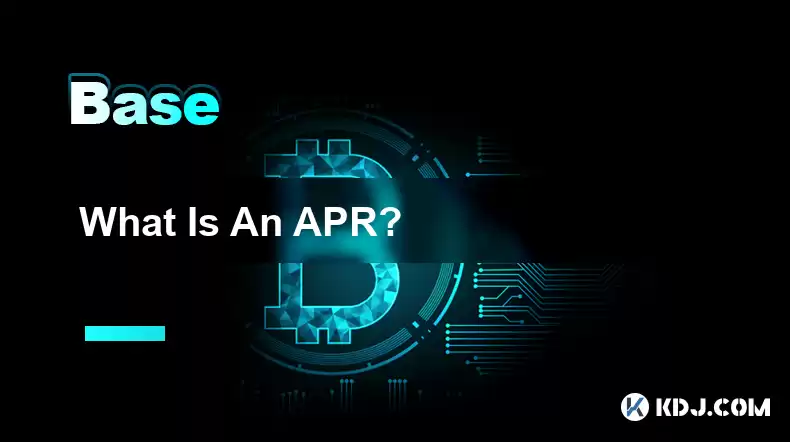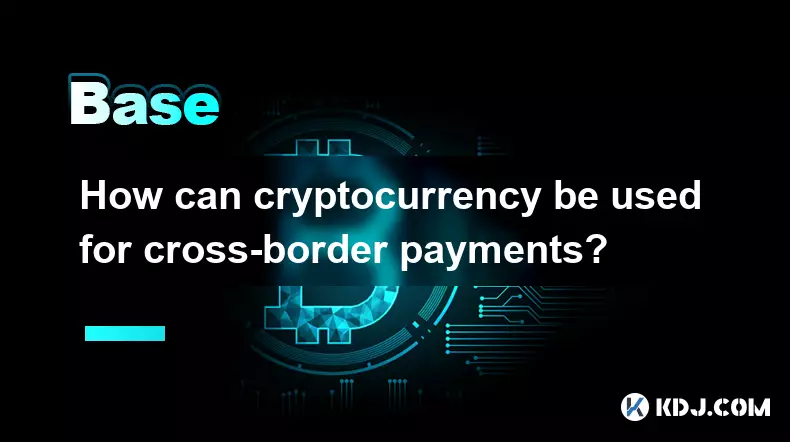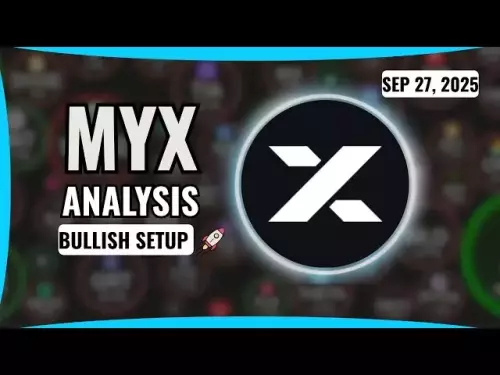-
 bitcoin
bitcoin $109523.663807 USD
-0.13% -
 ethereum
ethereum $4019.526508 USD
2.06% -
 tether
tether $1.000482 USD
0.00% -
 xrp
xrp $2.776815 USD
0.18% -
 bnb
bnb $958.942396 USD
0.12% -
 solana
solana $204.294698 USD
3.84% -
 usd-coin
usd-coin $0.999693 USD
0.00% -
 dogecoin
dogecoin $0.232115 USD
2.09% -
 tron
tron $0.338028 USD
0.84% -
 cardano
cardano $0.790920 USD
1.50% -
 hyperliquid
hyperliquid $44.871443 USD
5.60% -
 ethena-usde
ethena-usde $1.000322 USD
0.04% -
 chainlink
chainlink $21.034165 USD
2.60% -
 avalanche
avalanche $28.794831 USD
-0.54% -
 stellar
stellar $0.360466 USD
1.24%
What Is An APR?
APR, a critical metric for cryptocurrency lending, represents the yearly interest rate charged or paid, incorporating loan or investment fees and charges.
Dec 17, 2024 at 10:43 am

- Definition of Annual Percentage Rate (APR)
- Calculation of APR
- Types of APR
- Factors Affecting APR
- APR vs. APY
- APR in Cryptocurrency Lending
- Comparison of APRs on Different Cryptocurrency Platforms
Annual Percentage Rate (APR) is a key metric used to measure the cost of borrowing money or earning interest on savings. It represents the yearly rate of interest charged or paid on a loan or investment, expressed as a percentage. Unlike other interest rates, APR incorporates all loan or investment fees and charges into its calculation. This makes it a more accurate representation of the true cost or return of funds.
Calculation of APRAPR is calculated using the following formula:
APR = 100 * [(1 + Stated Rate/n) ^ n - 1]
- Stated Rate: the nominal interest rate on the loan or investment.
- n: the number of times interest is compounded per year.
For example, a loan with a stated rate of 10% compounded annually would have an APR of 10.25%:
APR = 100 * [(1 + 0.1/1) ^ 1 - 1] = 10.25%
Types of APRThere are two main types of APR:
- Fixed APR: The interest rate remains constant throughout the term of the loan or investment.
- Variable APR: The interest rate fluctuates based on a specific index or benchmark.
Several factors can affect APR, including:
- Creditworthiness of the borrower or investor
- Loan or investment amount
- Loan or investment term
- Lender or platform's policies
- Market interest rates
APR and Annual Percentage Yield (APY) are similar but distinct concepts. APY considers the effect of compounding interest, while APR does not. Compounding means that interest is earned not only on the principal but also on the accumulated interest.
APR in Cryptocurrency LendingAPR is a crucial consideration for cryptocurrency lending. It determines the cost of borrowing or earning interest on cryptocurrency assets. Different lending platforms offer varying APRs based on factors such as loan-to-value ratio, loan term, size of the loan, and the reputation of the borrower.
Comparison of APRs on Different Cryptocurrency PlatformsCurrently, the top cryptocurrency lending platforms offering high APRs include:
- Celsius Network: Offers up to 8.53% APR on Bitcoin, 14.77% on Ether, and 10.51% on USDC.
- Nexo: Provides up to 8.76% APR on Bitcoin, 16% on Ether, and 10% on USDT.
- Coinloan: Offers up to 7.2% APR on Bitcoin, 10.35% on Ether, and 13.65% on Tether.
- Hodlnaut: Provides up to 7.63% APR on Bitcoin, 12.73% on Ether, and 10.5% on USDC.
- Vauld: Offers up to 7.21% APR on Bitcoin, 12.81% on Ether, and 10.51% on USDC.
Q: What is the difference between APR and interest rate?A: APR is the annual rate of interest charged or paid, while interest rate is the nominal rate used for calculating interest on a loan or investment. APR includes all fees and charges, while interest rate does not.
Q: How do compounding intervals affect APR?A: Compounding intervals refer to the frequency at which interest is added to the principal. The more frequent the compounding intervals, the higher the APR.
Q: Is a higher APR always better?A: For borrowers, a lower APR is generally better as it means lower interest payments. For investors, a higher APR means higher interest earnings. However, APR is not the only factor to consider when making financial decisions.
Disclaimer:info@kdj.com
The information provided is not trading advice. kdj.com does not assume any responsibility for any investments made based on the information provided in this article. Cryptocurrencies are highly volatile and it is highly recommended that you invest with caution after thorough research!
If you believe that the content used on this website infringes your copyright, please contact us immediately (info@kdj.com) and we will delete it promptly.
- Bitcoin, mNAV, and Treasury Companies: A New York Perspective
- 2025-09-28 04:25:14
- BNB Price and the Rise of BlockchainFX: The Crypto Presale to Watch
- 2025-09-28 04:25:14
- Trump, WLFI, and the Token Burn: Can Burning Crypto Make it Great Again?
- 2025-09-28 04:45:15
- James Wynn's 3x Leveraged Crypto Gamble: ASTER Airdrop or Bust?
- 2025-09-28 04:45:15
- Vitalik Buterin Sounds Alarm on EU Legislation: Ethereum's Privacy Stance
- 2025-09-28 05:25:12
- XLM Records, Toncoin Utility, BullZilla Presale: Crypto's Next Big Thing?
- 2025-09-28 05:05:12
Related knowledge

What are some common methods of cryptocurrency market manipulation?
Sep 27,2025 at 02:55am
Wash Trading and Its Impact on Market Perception1. Wash trading involves an individual or entity simultaneously buying and selling the same cryptocurr...

How do I read a cryptocurrency whitepaper?
Sep 27,2025 at 05:54am
Understanding the Structure of a Cryptocurrency Whitepaper1. Begin by identifying the executive summary, which outlines the project’s core vision and ...

Can I recover lost cryptocurrency?
Sep 25,2025 at 08:18am
Understanding the Nature of Cryptocurrency Loss1. Cryptocurrency operates on decentralized networks, meaning there is no central authority to reverse ...

How do I choose a cryptocurrency investment strategy?
Sep 27,2025 at 03:55pm
Understanding Risk Tolerance in Crypto Investing1. Assessing personal risk tolerance is a foundational step when entering the cryptocurrency market. V...

How can I earn passive income from cryptocurrency?
Sep 23,2025 at 10:18am
Staking Cryptocurrencies for Regular Returns1. Many blockchain networks operate on a proof-of-stake (PoS) consensus mechanism, allowing users to earn ...

How can cryptocurrency be used for cross-border payments?
Sep 28,2025 at 01:36am
Efficiency in International Transactions1. Cryptocurrency enables near-instant settlement across borders without relying on traditional banking interm...

What are some common methods of cryptocurrency market manipulation?
Sep 27,2025 at 02:55am
Wash Trading and Its Impact on Market Perception1. Wash trading involves an individual or entity simultaneously buying and selling the same cryptocurr...

How do I read a cryptocurrency whitepaper?
Sep 27,2025 at 05:54am
Understanding the Structure of a Cryptocurrency Whitepaper1. Begin by identifying the executive summary, which outlines the project’s core vision and ...

Can I recover lost cryptocurrency?
Sep 25,2025 at 08:18am
Understanding the Nature of Cryptocurrency Loss1. Cryptocurrency operates on decentralized networks, meaning there is no central authority to reverse ...

How do I choose a cryptocurrency investment strategy?
Sep 27,2025 at 03:55pm
Understanding Risk Tolerance in Crypto Investing1. Assessing personal risk tolerance is a foundational step when entering the cryptocurrency market. V...

How can I earn passive income from cryptocurrency?
Sep 23,2025 at 10:18am
Staking Cryptocurrencies for Regular Returns1. Many blockchain networks operate on a proof-of-stake (PoS) consensus mechanism, allowing users to earn ...

How can cryptocurrency be used for cross-border payments?
Sep 28,2025 at 01:36am
Efficiency in International Transactions1. Cryptocurrency enables near-instant settlement across borders without relying on traditional banking interm...
See all articles










































































